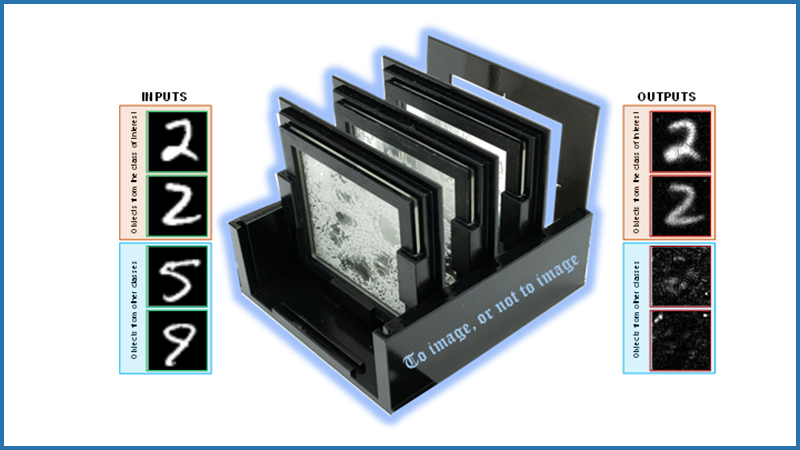Novel Privacy-Preserving Camera Captures Only Objects of Interest at Speed of Light

The Ozcan Research Group/UCLA
Illustration of a UCLA-developed privacy-preserving, class-specific diffractive 3D camera that instantaneously erases sensitive or unwanted data
Over the past decade, digital cameras have become ubiquitous in nearly every aspect of modern living — embedded in smartphones, smart eyewear, security surveillance systems, autonomous vehicles and facial recognition technologies. As enormous amounts of image data are being captured by these cameras everywhere, there are growing concerns about privacy protection.
To address this problem, a research team led by UCLA Samueli School of Engineering’s Volgenau Professor for Engineering Innovation Aydogan Ozcan designed a smart camera that takes pictures of only relevant objects while instantaneously preventing other details from being captured.
The team recently published a research paper in eLight that demonstrated the new paradigm to achieve privacy-preserving, secure imaging by building a camera using artificial intelligence, which does not require any digital post-processing currently used by algorithms in apps that blur individuals’ faces or encrypt sensitive data such as Social Security numbers.
Removing such data after an image is taken risks hacking or exposure of the original, unaltered image, especially if it is stored in the cloud — not to mention that such processing will require additional steps that are data-intensive and consumes more power. Other efforts to address this problem use customized cameras to conceal sensitive identifiable information but at the same time downgrade and sacrifice the image quality for the objects of interest.
“We’d like to design a robust, power-efficient and secure smart camera that can safeguard privacy by controlling what a camera lens sees and captures before one clicks the shutter,” Aydogan Ozcan said.
“We’d like to design a robust, power-efficient and secure smart camera that can safeguard privacy by controlling what a camera lens sees and captures before one clicks the shutter,” said Ozcan, who is also the associate director of entrepreneurship, industry and academic exchange at the California NanoSystems Institute at UCLA.
The camera consists of up to seven transmissive, 3D-printed surfaces, each composed of tens of thousands of diffractive features at the scale of the wavelength of light. Using deep learning-based training, the team fabricated and assembled the structure of these successive layers. When the input objects from the target optical fields appear in front of the camera lens, they are captured as high-quality images, whereas when the input objects belong to other undesired classes, they are optically erased, forming random and low-intensity patterns that become noise in the background of an image.
Since the characteristic information of undesired classes of objects is optically erased at the camera output through light diffraction, this AI-designed camera never records such information. This enables optimized privacy protection since any attempt to access the recorded images of the camera will fail to reconstruct the original objects. This feature can also reduce cameras’ data storage and transmission load since the images of undesired objects are not recorded.
To demonstrate this unique data-specific camera, the UCLA research team constructed a 3D-printed camera using terahertz waves to illuminate handwritten digits and train the camera to capture only one class of handwritten digits and ignore the others.
During the experiments, the smart camera was able to image the input objects only if they were handwritten digits “2”, while instantaneously erasing all the other handwritten digits from the output images. The team also demonstrated that the camera was able to image a particular type of clothing, such as trousers, while omitting other clothing items from the output of the camera. The research team tested its design under varying lighting conditions that were not previously included in the camera’s training and showed that the camera was able to accommodate a wide range of variations in illumination.
Beyond data-specific imaging, Ozcan said the same AI-based camera design could also be used to build encryption cameras, providing an additional layer of security while preserving an original image. Using AI-optimized diffractive layers, such cameras can optically perform a selected linear transformation, exclusively for the target objects of interest. Only those with access to the decryption key can recover the object’s original image. On the other hand, the information of undesired objects is irreversibly deleted since the AI-designed camera erases them at the output. Therefore, even if the decryption key is applied to such recorded images, it yields noise-like, unrecognizable features.
Except for the illumination light, the smart camera does not require any external power for its computation and operates at the speed of light, making it fast as well as data- and energy-efficient. This technique is especially suitable for task-specific, privacy-focused and power-conserving imaging applications. “The core AI training of this diffractive camera design can lead to future imaging systems that consume orders of magnitude less power in computing and data transmission,” Ozcan said.
Supported by the U.S. Office of Naval Research and the U.S. Department of Energy, the research team includes UCLA’s Northrop Grumman Endowed Chair in Electrical Engineering Mona Jarrahi, who is also the director of the Terahertz Electronics Laboratory. The other authors of this work, all members of the UCLA Electrical and Computer Engineering Department, are graduate students Bijie Bai, Yi Luo, Tianyi Gan, Yuhang Li, Yifan Zhao, Deniz Mengu and postdoctoral researcher Jingtian Hu.
